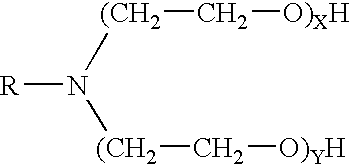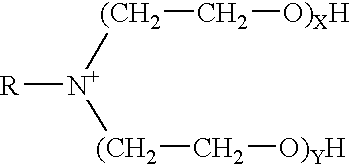Methods of fracturing a subterranean formation using a pH dependent foamed fracturing fluid
a technology of fracturing fluid and subterranean formation, which is applied in the direction of sealing/packing, chemistry apparatus and processes, and well accessories, etc., can solve the problems rendering the fracturing operation useless, and affecting the ability of the proppant to be properly released, etc., to achieve the effect of reducing the foam level in the fracturing fluid
- Summary
- Abstract
- Description
- Claims
- Application Information
AI Technical Summary
Benefits of technology
Problems solved by technology
Method used
Image
Examples
examples
[0023]The invention having been generally described, the following examples are given as particular embodiments of the invention and to demonstrate the practice and advantages hereof. It is understood that the examples are given by way of illustration and are not intended to limit the specification or the claims to follow in any manner.
examples 1 and 2
[0024]The following procedure was followed in both Examples 1 and 2: a fracturing fluid was prepared by blending 880 mL of distilled water and 120 mL of depolymerized hydroxypropyl guar gum, i.e., the gelling agent, until the gelling agent was fully hydrated. The resulting solution had a viscosity of 9.1 centipoise, as determined using a FANN 35 viscometer equipped with a ⅕ spring. Next, 100 mL of the solution was poured into a 1 L blendor jar marked at 100 mL increments. About 0.5%, of tertiary alkyl amine ethoxylate with 10 moles of ethylene oxide, i.e., the surfactant, based on the total volume of the water was then added to the solution. The initial pH of the mixture was measured to be 11.39. The blendor was then operated at a very low blendor speed to slowly build foam in the mixture. The blendor speed was then increased to generate a stable foam having a fine texture. The mixture was blended in this manner until the maximum foam height had been achieved. The foamed fluid was t...
examples 3 and 4
[0027]The procedure followed in Examples 1 and 2 was followed in these examples except that the surfactant employed in the fracturing fluid was tertiary alkyl amine ethoxylate with 15 moles of ethylene oxide. Table 2 below provides the results of these examples.
[0028]
TABLE 2SurfactantConcentration,Viscosity ofpHFoamExamplegal / M galBase Gel, cPof FluidQualityHalf-Life359.111.397116:5159.1741 1:0759.1857 5:3159.197117:0359.111.47415:39459.111.497219:1459.1738 1:3359.186211:0559.197219:1259.111.467218:27
[0029]Table 2 illustrates that the quality and the half-life of the foam were initially high when the pH of the fluid was above 11 in both Examples 3 and 4. However, the fluid experienced large drops in the half-life and the foam quality when its pH was lowered to 7. The quality and the half-life of the foam increased when the pH of the fluid was raised to 8. Further, they increased even more, reaching about what they were originally, both when the pH of the fluid was raised to 9 and wh...
PUM
| Property | Measurement | Unit |
|---|---|---|
| viscosity | aaaaa | aaaaa |
| volume | aaaaa | aaaaa |
| fracture | aaaaa | aaaaa |
Abstract
Description
Claims
Application Information
 Login to View More
Login to View More - R&D
- Intellectual Property
- Life Sciences
- Materials
- Tech Scout
- Unparalleled Data Quality
- Higher Quality Content
- 60% Fewer Hallucinations
Browse by: Latest US Patents, China's latest patents, Technical Efficacy Thesaurus, Application Domain, Technology Topic, Popular Technical Reports.
© 2025 PatSnap. All rights reserved.Legal|Privacy policy|Modern Slavery Act Transparency Statement|Sitemap|About US| Contact US: help@patsnap.com



